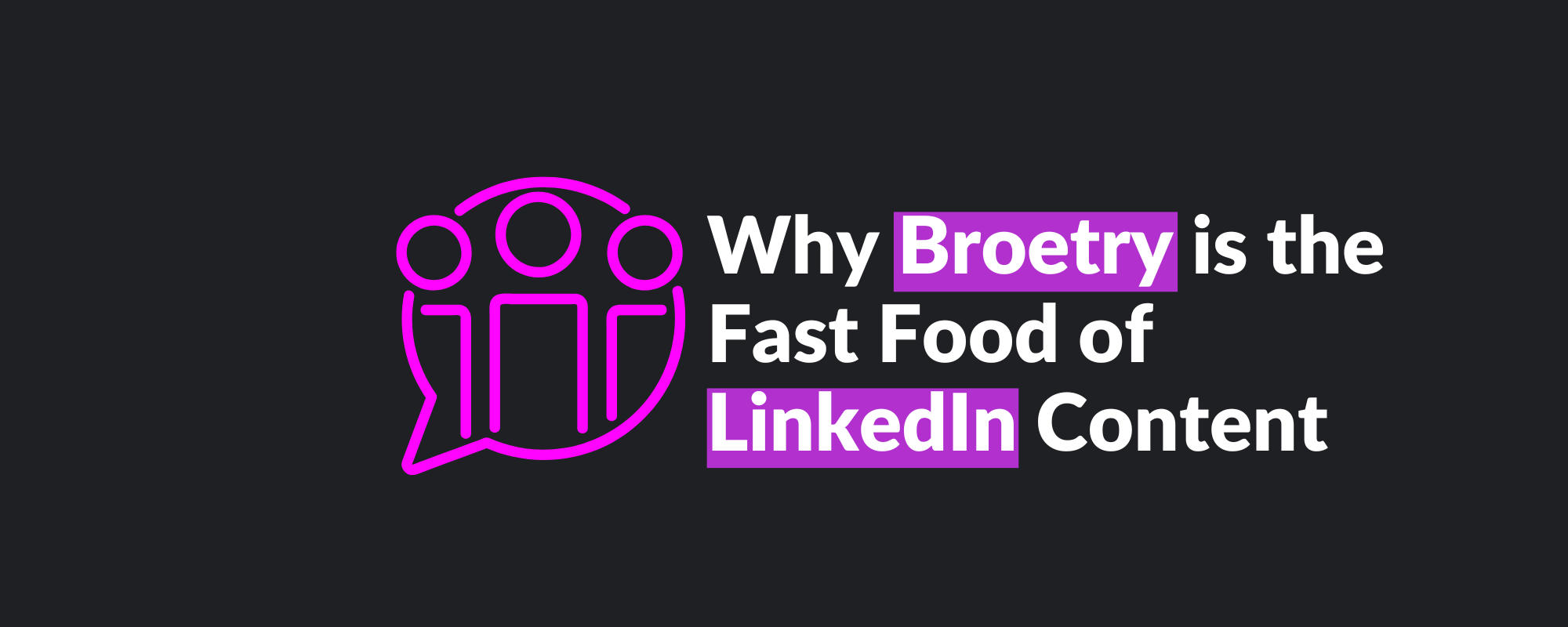Why Broetry is the Fast Food of LinkedIn Content

LinkedIn: the platform where professionals build connections, share insights, and—lately—get bombarded with a growing flood of shallow content. One type of post has become so prevalent, it’s hard to avoid: Broetry. If you’ve seen it, you know exactly what I’m talking about.
One-liners.
Short paragraphs.
A lot of empty air between them.
Broetry is designed to look deep and thoughtful, but like fast food, it’s unsatisfying once consumed. It’s poetry for the “bros”—those obsessed with #hustle, the art of the humblebrag, and, most importantly, attention.
Here’s the thing: Broetry games the system, draws clicks, and pulls in engagement. But, just like fast food, it’s unhealthy for a platform’s long-term value.
And trust me, it won’t last.
The Birth of Broetry
Broetry emerged around 2017 when LinkedIn’s algorithm started rewarding posts with longer dwell time—content that kept people scrolling. It wasn’t about the quality of insights or value of the post; it was about the user interaction that prolonged engagement.
People like Josh Fechter discovered that by breaking every sentence into a single line, they could stretch out simple thoughts into something that looked profound. More scrolling meant more algorithm love. The easier it was to read, the better the algorithm would treat it.
Fechter wasn’t the only one who caught on. Broetry spread because it was an easy shortcut to get attention on LinkedIn. And the formula was simple:
- Clickbait opener: Something like, “I almost didn’t post this, but here’s the truth…” or “Here’s the one thing no one tells you about success…”.
- Dramatic, exaggerated story: Think, “I was late for a job interview, stopped to help someone who fell, and it turned out they were the CEO. I got hired on the spot.”
- Overuse of emojis: To punctuate key moments—💡 for ideas, 💪 for hustle, 😢 for emotional appeal.
- Frequent line breaks: Stretching out what should be two paragraphs into a scroll marathon.
- Inspirational conclusion: Often paired with a call to action, “Like if you agree that kindness is the key to success.”
Broetry became popular because it hacked LinkedIn’s algorithm, which cared more about time spent on posts than the substance of what was being shared. The problem wasn’t engagement; it was quality engagement.
The Formula’s Real Appeal (and Problem)
Broetry works because it taps into something psychological: we’re wired to respond to short, snappy sentences. They feel easy to digest, like the mental equivalent of fast food. Add a dramatic, emotional story—often embellished—and you’ve got the recipe for engagement.
It’s a tactic not limited to LinkedIn. Clickbait thrives on similar principles across platforms. On YouTube, for instance, thumbnails and titles promise outrageous content (“You won’t believe what happens next!”) that rarely lives up to the hype. Instagram stories often follow a similar trend, where influencers tease “big reveals” or “surprising truths” to get you to click, but deliver nothing of real value.
The issue here is the same: it’s all surface. The posts promise profound insights but rarely deliver anything substantial.
And like clickbait articles, YouTube thumbnails, and Instagram influencer stories, broetry is not built to last. Audiences get wise to the formula quickly. What worked once eventually becomes background noise.
The Rise of Fatigue
It didn’t take long for LinkedIn users to catch on. Scroll fatigue set in as more people recycled the same broetry formula. What once caught attention now induces eye rolls. We’ve all seen the posts that start with “Here’s what no one tells you about success…” and end with an overused cliché and a flexing bicep emoji.
The problem with trends like broetry is that they thrive on novelty. They offer an initial jolt of engagement, but once the novelty wears off, there’s nothing left. Audiences grow tired of seeing the same template over and over again.
Here’s the bottom line: Broetry is unsustainable because it doesn’t deliver true value. It’s an exercise in attention-seeking for those who post daily but have little to say.
What audiences are really craving is substance. They want content that makes them pause, think, or learn something new. As more LinkedIn users begin to prioritize meaningful insights over empty engagement tactics, broetry will fade into obscurity.
Chasing Attention vs. Adding Value
The real failure of broetry is that it confuses attention with value. Just because a post racks up likes and comments doesn’t mean it’s valuable. Many broetry writers—let’s call them broets—confuse the dopamine hit of engagement metrics with the delivery of actual insights. They post frequently, trying to stay in the spotlight, but offer nothing substantial.
True thought leadership isn’t about chasing attention. It’s about offering something new, sparking meaningful conversations, and adding value to the lives of your readers. Broetry, by design, does none of these things. It’s short-term content for short-term engagement.
As with all social media platforms, algorithms evolve. Just as Facebook reduced the impact of clickbait headlines and Instagram clamped down on “engagement bait” posts, LinkedIn will likely adjust its approach. When that happens, broetry will become just another failed trend that couldn’t stand the test of time.
What Comes Next?
As audiences grow tired of broetry, LinkedIn’s content landscape will evolve. The algorithm itself may adjust to prioritize more meaningful engagement. But, more importantly, the audience will begin to demand something more substantial.
Real thought leadership will take center stage—content that challenges the status quo, introduces new ideas, and sparks thoughtful discussions. The posts that succeed will be those that deliver real insights, not just emotional manipulation or hollow inspiration.
Broetry will fade because, at its core, it’s unsustainable. It relies on a formula that’s already growing stale. It’s built on the idea that you can game the system with engagement tricks rather than delivering meaningful content. But as audiences wise up, they’ll start ignoring these shallow posts, and the algorithm will eventually catch up.
Broetry is for those who need attention but have nothing to offer. And while it might work for a while, it’s not a sustainable way to build a reputation or an audience.
The future belongs to those who write with depth, purpose, and authenticity. The ones who craft content that makes people stop, think, and learn something new. Those are the creators who will thrive in the digital landscape.
So, mark my words: broetry will disappear. And when it does, LinkedIn will be better for it. The platform will be filled with real conversations, real value, and genuine thought leadership. The noise? That will be long gone.


Discussion